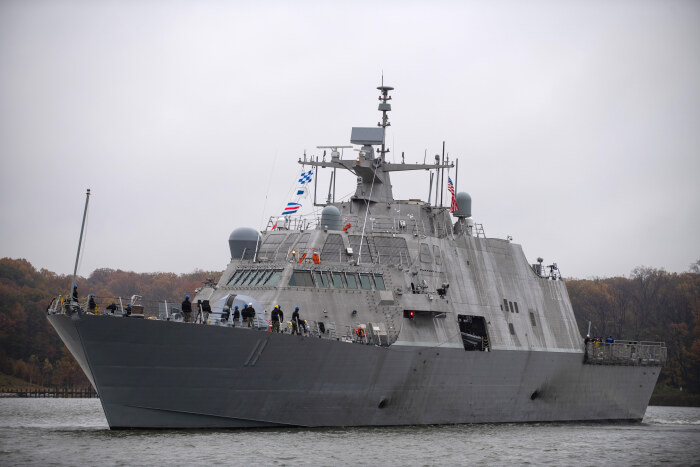Randy Evans is executive director of the Iowa Freedom of Information Council and can be reached at DMRevans2810@gmail.com. Joaquin Sapien reported for ProPublica on September 7 about the Navy’s spending on littoral combat ships, which “broke down across the globe” and are being decommissioned.
Iowa is about as far removed from an ocean as you can get. But this state figures in recent news reports about the U.S. Navy—and not in a puff-up-our-chest-with-pride way.
One of the reports was a New York Times examination of the Navy’s largest ship-building budget in history, $32 billion this year alone, and the tug-of-war that pot of money has created inside the seagoing service.
On one side of the budgetary rope are those who favor building traditional warships, the submarines, destroyers and frigates that make up most of the Navy’s hardware. On the rope’s other end are those who want the Navy to invest more of its construction budget in a new breed of surface vessels, submersibles and drones that are unmanned and less expensive to build.
There is an urgency to this debate, because China’s naval forces surpassed the U.S. Navy’s vessel numbers several years ago.
So, what does this have to do with Iowa?
While the Times was writing about the Navy’s construction budget debate, there was a ceremony on August 14 at the Mayport Naval Station in Jacksonville, Fla. The occasion for the pomp and circumstance was the official “decommissioning” of the USS Sioux City. In rural lingo, the Sioux City has been put out to pasture. It will be parked and mothballed, its crew of 75 sailors given new assignments.
What makes the decommissioning so remarkable are a couple of facts that should anger frugal people from Iowa and beyond: It cost $360 million—one-third of a billion dollars—to build the Sioux City. The ship set sail in 2018. Now it has been retired after four years and nine months of service—far short of its intended service life of 25 to 30 years.
Therein lies the problem.
The Pentagon and the Congress both seem averse to saying “no” to anything associated with more military spending. The Defense Department asked Congress this year for $840 billion, almost half of the federal government’s discretionary spending.
Once a new series of ships or airplanes or other weapons systems gets approved, lobbyists for military contractors and home-state members of Congress where those factories or military installations are located swing into action to keep the money flowing.
Those who protest often are labeled unpatriotic or against U.S. security interests.
That the Pentagon frittered away $360 million on the USS Sioux City—and equal or larger sums on three sister ships that been mothballed, too—is especially aggravating at a time when some in Congress are questioning whether our nation can justify longstanding promises it made on Social Security, Medicare and Medicaid health benefits, and food assistance for low-income people.
The Sioux City is a littoral combat ship that was intended to be part of a fleet of 52 small, fast ships that could maneuver on the open seas or in shallow waters closer to shore than other Navy vessels. These littoral combat ships were intended to hunt submarines, locate mines and intercept suspicious boats, including smugglers and drug-runners.
But the LCS design has been beset by problems from its earliest days. It is called a “gas hog,” because its fuel costs are comparable to larger ships. Sailors complained they spent more time fixing the ships than sailing them.
Indeed, Navy insiders have taken to saying LCS stands for Little Crappy Ship.
A spokeswoman for the Sioux City’s old squadron at Mayport Naval Station recently gave the Sioux City Journal this clear-as-mud explanation for why the Navy is retiring the ship: “To maintain our strategic advantage, particularly under fiscal constraints, it is important for the Navy to carefully review our force structure regularly and divest of legacy capabilities that no longer bring sufficient lethality to maximize our effectiveness in deterring and defeating potential adversaries.”
Americans like to parcel out blame for a government blunder by pointing fingers at one political party or the other. As often is the case with Pentagon spending, however, Republicans and Democrats in Congress, and in the White House, too, equally embraced the littoral combat ship design.
Lyle Goldstein, a former U.S. Naval War College professor who studies military costs, told ProPublica, “There is a lot of money flowing through this vast ecosystem, and somehow the only thing all these people can agree on is more, more, more.”
Top image: The USS Sioux City sails toward the U.S. Naval Academy for its official commissioning in 2018. U.S. Navy photo.

